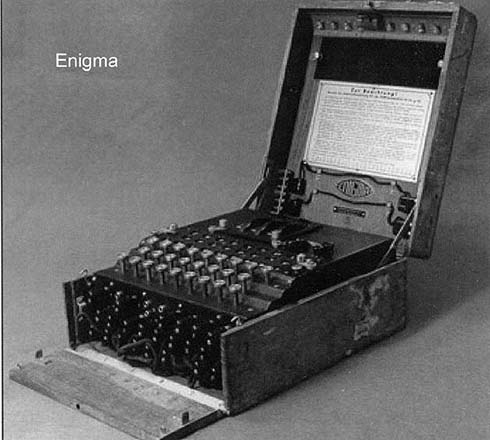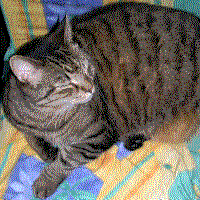Obs. This article was originally published in Portuguese in Facta Magazine in 2015.
Steganography is the art and science of writing hidden messages in such a way that no one knows the message exists. It is different from cryptography, where a message has its existence known, but no one knows how to decipher it.
A scrambled text, as produced by the famous Enigma machine, is an encrypted text.

A text "Written backwards", as Leonardo da Vinci used to do, in a way that it could only be read with the aid of a mirror is also an example of cryptography.
However, a microdot in a message that no one knows exists is a steganographic message.
The word "steganography" is attributed to Johannes Trithemius, spelled Steganographia, as the in the title of his book in which the author dealt with these techniques as "black magic".
The reader should not confuse steganography and stenography, which is the iechnique of writing quickly and short by hand, much used by secretaries who, beforc the advent of the recorder, had to keep note of everything that was going on at a meeting or even letters dictated by bosses.
To get to a steganographic text, it is common that it is encrypted first in other words, passed through some type of process that makes it unreadable. Then, the same text is modiñed in a way that its presence can not be detected.
An interesting example of steganography took place in the times of the ancient Greeks. In those times, boards with secret texts were covered with wax so that the message was hidden.
So when the wax was melted or removed it could be read.
Another example is given by Herodotus, "The Father of History". Facing the Persian invasion, he needed to secretly warn a general about it. He suggested that the king should order to shave a slave's head, Where he tattooed a message.
After the hair had grown, he sent oif the slave to seek the general with the simple order of shaving his head. If he fell into enemy hands, the slave would not know the content of the message (because he could read what was on his head) and the enemies certainly would not think to look for a message there.
It is clear that, in our time, in which messages need to be sent quickly, this technique wouldn't work. But today there are very interesting variations to the technology used in steganography that may be being used right now.
A modern example can be given in the files being transferred over the Internet that can hide secret messages in an extremely interesting way.
Digital Steganograpby
Ordinary information sent through digital media has a feature that easily allows them to be used to encode hidden messages.
From the fact that digital images are formed by sets of bits that indicate the percentage with which each color is present we can use it in a very interesting way, as found in online research.
A RGB bitmap image, A for example, uses 24 bits, there being 8 bits to represent the color (red, green and blue) of each pixel With 8 bits we have 256 levels of primary colors,.which is more than enough for us to combine these levels, obtaining millions of combinations for the final coIors. A
If we reduce this amount by half, our vision probably won't notice much difference. This means that we can use, for example, the last two bits of the proportion in which each color goes into each point to embed a secret text or image.
With two bits of each color point, we have 6 bits in each pixel, which is more than enough to embed characters and numbers in an image, as well as graphics signals.

So that the reader can have an idea of the potential in which this occurs, We have found in Wikipedia an interesting example of steganography done with a bitmap image, using two bits of each color component.
The original image is shown in Figure 2. Removing the last two bits of each color component of this file We obtain a virtually black image. However, if we multiply the brightness of this same image by 85, we have the picture shown in figure 3.

In other Words, we have an image "embedded" in another, so that no one knows of its existence, unless the receiver of the image. In this case it was just an innocent kitten, but one can embed a secret weapon plan!
The greater the number of bits used in the transmission of an image, the easier it is to hide a message or a second image Without this being realized and with the possibility of obtaining a greater concealment capacity for the secret message.
For this reason, digital images available on the Internet are a "full plate" for the malicious who wish to send secret messages in a practically undetectable way.
It is speculated that Bin Laden himself has used this feature to send orders to his subordinates, in a simple way, although this has not been proved. One only had to apply a simple technique image extraction to immediately reveal the steganographic message or image!
The most serious part of this technique is that the introduction of secret information in a ordinary image becomes virtually undetectable. There is pratically no visible change in the image sent that could lead to a possible interceptor to suspect something, as we have seen in the images given as an example.
In the transmission of digital images with JPEG or MPEG compression itself, one can include steganographed secret messages with ease. In the transmission of compressed images the introduction of noise to replace some redundancy is common. This noise, in the case of digital TV and compressed images (Which can be sent from mobile phones) consists of a set of random bits. However, nothing prevents them from being replaced by a non-random sequence to convey a secret message.
Only the receiver who knows about this content can apply the algorithm in order to extractt it. Others won't have a clue that this message exists! For them, those extra bits, if accessed, will be interpreted as noise.
OTHER TECHNIQUES
There are several interesting techniques, some involving electronics, which let you hide a seemingly innocent message in another or images or objects. Lets name a few:
INVISIBLE INK
You can write an innocent letter to a relative and within the lines a secret message With invisible ink. Only those who know of the existence of the second message can reveal it.
If the reader likes to experiment with different stuff, you can write a secret message With invisible ink, for which we give the following formula (Which is far from secret).
Dissolve half-and-half water and detergent, filling an ordinary fountain pen with the mixing. Write the message of disguise with a ballpoint pen and in between the lines write the secret message with the described invisible ink.
While waiting for the paint to dry off, you will see that the secret message disappears. To reveal it, you just need to wet the paper or burn it slightly With the heat of an incandescent lamp.
MICRO-DOTS
This is a technique much used by spies before James Bond (Which is "high tech"). Spies in World War II used this feature very much.
The technique consists of photographing the message or secret plan and then reduce the image to a microdot using a special camera adapted to an inverted microscope, as shown in figure 4, from a Leica magazine cover from 1934.
Figure4 – Microphotography equipment
Then, the microdot can be placed under the stamp of a normal letter or even replace the "i" character dot of a given text, already known by whoever receives the message.
Several microdots in a message allow for sending long documents and secret plans.
Terrorism and Counter measures
It is speculated that the orders given by Bin Laden for the attacks of September 11 have been made through steganographic images published in public sites such as eBay.
The messages were supposed be "lost" over the millions of images online and only those who knew exactly where they were and how to extract them would have access to their content.
The terrorists of Al-Qaeda were also supposed to be sending emails with hidden messages, which would easily pass unnoticed in standard texts, as the steganographic techniques teach us.
The New York Times itself published articles in 2001 stating that Al-Qaeda used steganographic techniques to contact their agents. However, many of these speculations lost their power when the correspondent Jack Kelley, one of those who claimed the existence of these techniques, was caught in a major scandal in 2004, for inventing fantastic stories and forging non existent sources.
Later, however, a training manual of that organization was captured and there were no citation of any steganographic technique (or it would also be steganographied so no one would know...).
According to the manual the militants of that organization still relied on old techniques of ciphers and codes for their messages.
Anyway, the fact that we know that this technology exists and that it is possible to steganograph disguised messages in just about anything causes us to rethink our analysis capability.
The analysis of steganographic messages is called “steganoanalysis". A simple way of detecting a hidden message that is available online in the form of an image or any other file is to carefully compare it with its original, detecting changes.
It is obvious that, for this, we must have access to the original file.
Considering the fact that any agent can use an image available online to "embed" a message, the discovery of the original image can be of great value to decode the secret message.
There are even commercial software that does this.
What can get in the way is that the application of compression algorithms on an image, which in some cases act randomly or depending of the media, make even images that do not carry anything special beyond themselves be different files, according to the location in which they are received.
Conclusion
Together with cryptography (the art of encrypting messages), steganography is a powerful tool for hackers, secret agents, terrorists and spies of all levels.
We don’t know how many of the images that we “innocently" access on the Internet, some of them beautiful enough for us to download as wallpaper, bring in their "digital inside" information that could shake the world, such as secret formulas stolen from laboratories, chemical weapons recipes, missile plans and even nuclear bombs.
Has the reader ever considered the possibility of the downloaded wallpaper that now decorates the screen of your monitor can bring a terrible secret able, to end the world?




